by Bill Murray
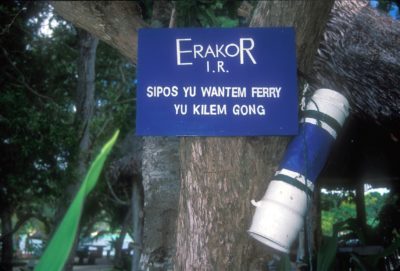 It’s 6:15 on the Erakor Lagoon in Vanuatu. Women in bright print skirts paddle canoes from villages into town. Yellow-billed birds call from the grass by the water’s edge, roosters crow from somewhere, and the low rumble of the surf hurling itself against the reef is felt as much as heard.
It’s 6:15 on the Erakor Lagoon in Vanuatu. Women in bright print skirts paddle canoes from villages into town. Yellow-billed birds call from the grass by the water’s edge, roosters crow from somewhere, and the low rumble of the surf hurling itself against the reef is felt as much as heard.
Every morning the sky is grayer than blue. Clouds hang close to the hills and the water is green glass, reflecting jungle. We’re staying on a tiny island near the capital city, Port Vila. Last night the heavens inflicted a pounding rain just as we arrived at the ferry dock.
We rise to gasp at the wages of yesterday’s folly – snorkeling from an outrigger in the midday sun. Good bet we’ll stay out of the sun today; we could plausibly be served up as steak tartare, and anyway there’s the thunder, the no fooling rumble you feel through your bare, pink feet in the grass, through the earth.
Vanuatu’s colonial name was New Hebrides. It’s about 80 islands a thousand miles east of Australia. When colonial hands came off, Port Vila was left more British than French. The two countries governed the New Hebrides in an arrangement they called a condominium from 1906 until independence in 1980.
It took Europeans until 1606 to ‘discover’ this archipelago, and by the time the Spanish explorer Pedro Fernandez de Quiros arrived the islands had been inhabited for some 3600 years. The colonial arrangement between British and French lasted 74 years. It was the only time Britain and France jointly ruled a colony like that for an extended period. They called it a Condominium; the locals called it the ‘Pandemonium.’
•••••
The domestic flight terminal is like Kathmandu your first time, long ago, or maybe like in a 1990s former communist provincial capital (just imagining now, say, Timisoara). A cash-strapped country’s inclination seems to be to spend what resources it has on its international terminal, its countrymen and the wayward few who venture beyond the gateway be damned.
We had utterly no idea where we were going. Our flight to Espiritu Santo island, home to Vanuatu’s second city of Luganville, had an interim stop at Craig’s Cove, Ambrym Island. My map of Vanuatu showed two little airplanes on Ambrym, so I asked the check-in desk which it would be.
Blank looks. Much consultation. Study the maps. Ask the man in the back, ask the baggage boy. No one knew, but eventually we found it, an indistinct blue mark not near a town, and that brought relieved smiles from the check-in man.
(Besides the existence of more than a hundred Ni-Vanuatu languages across the archipelago, in the colonial period both sides of the British/French condominium taught their own languages – really, they duplicated most everything. A pidgin called Bislama, mostly English, served as a bridge and became the first or second language of most people who live in towns.
The door to domestic departures spoke three languages English, French, and Bislama. Respectively, it read: ‘passengers only,’ ‘réservées aux passagers,’ and ‘pasensa no mo.’)
We filed in. 20 seats in a Twin Otter, 16 full. One European family with their little girl, one huge white man in seat one, carrying on a running conversation with the pilot (it wasn’t a big plane) who brought his son, a 20-ish couple in love, students from New Zealand (you learn these things in about a day and a half because you meet every expat in Santo), four locals and us.
Vanuatu’s main island Efate, where Vila is, brooded in cloud – its out-islands just north likewise under steely gray. But Malakula, just northwest, in sight of Efate, was fine, sunny with a blue chop off its shore. By Ambrym, 40 minutes later, the coast was clear.
Craig’s Cove was a few houses in a pretty bay maybe three-quarters of a kilometer wide, gleaming in the morning sun. The air strip used to be paved. Now it was pot-holed with grass growing through it and landing shook the wheels pretty bad. This was not unusual. At domestic check-in a chalk board declared “Longana air strip closed until further notice – tall grass.”
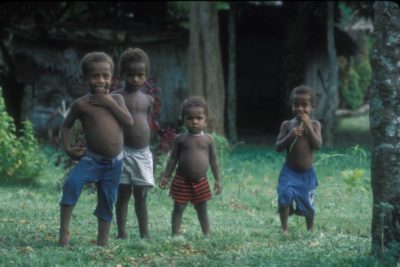 Dirty boys with gleaming smiles ran out to meet the plane. A torn and ratty windsock had fallen into such disrepair that it lost its utility though it still hung on its pole. We let off two and took two on in Ambrym, along with a bag of coconuts. The two who left carried boxes from Telecom Vanuatu Limited Radio Systems Department and an antenna bundled into sections. It was so hot on the ground the plane began to sweat from above, dropping beads of water onto our thighs. Ancient pickup trucks appeared out of the jungle for the Vanuatu Telecom men, and while we sat in Craig’s Cove we let in hordes of flies.
Dirty boys with gleaming smiles ran out to meet the plane. A torn and ratty windsock had fallen into such disrepair that it lost its utility though it still hung on its pole. We let off two and took two on in Ambrym, along with a bag of coconuts. The two who left carried boxes from Telecom Vanuatu Limited Radio Systems Department and an antenna bundled into sections. It was so hot on the ground the plane began to sweat from above, dropping beads of water onto our thighs. Ancient pickup trucks appeared out of the jungle for the Vanuatu Telecom men, and while we sat in Craig’s Cove we let in hordes of flies.
From Ambrym it was a brisk 20-something minutes up to Santo, flying at 4,000 feet, an altitude at which you can intimately study the blue chop of the South Pacific. I read over the shoulder of a Ni-Vanuatu man across the aisle. He was reading Charles Capps’ “The Tongue A Creative Force.”
“Watch your words” was the chapter.
I read the phrase, “I’ll deny you before the Father,” and a sub-heading, “God’s word is wisdom.”
•••••
Clouds welled up across a narrow channel called Segond from our garden perch outside town. Behind the palms the weather remained fine, high cirrostratus, heavens a royal blue. Still seared crimson, we hid in the shade of the covered cement porch of a bungalow near Luganville, Vanuatu’s second city.
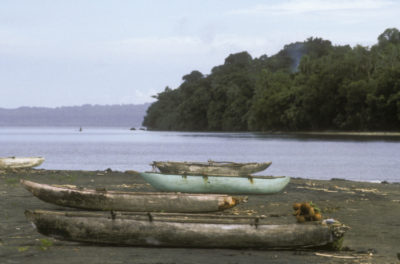 We’d taken our already burned bodies out to comb the beach in the midday sun alongside sensibly brown kids and a man checking fish traps with a snorkel, and we knew we were acting foolishly, pushing our luck. So here on the porch we savored a gathering storm as the wind kicked up, the cranberry hyacinths and pink and yellow flowers fluttering before our booty: shells, a rusty spoon, and a 14 inch end-to-end lower jaw bone with two remaining teeth and an abscess.
We’d taken our already burned bodies out to comb the beach in the midday sun alongside sensibly brown kids and a man checking fish traps with a snorkel, and we knew we were acting foolishly, pushing our luck. So here on the porch we savored a gathering storm as the wind kicked up, the cranberry hyacinths and pink and yellow flowers fluttering before our booty: shells, a rusty spoon, and a 14 inch end-to-end lower jaw bone with two remaining teeth and an abscess.
We found it floating up and down with the tide and asked three men who conferred and decided it was bulu. Later a man thought it was a pig. Maybe bulu is pig, I’m not sure. They might also have been saying ppulu, which might mean sticky. I found this in a dictionary of a Ni-Vanuatu language, Mele:
“ppulu (vi) Stick to, be stuck to. T’loli eppulu gaia t’teepele. The lolly is stuck to the table.”
Beats me.
I fashioned myself a ground-breaking underwater archeologist with that spoon, imagining it from the mess kit of a heroic World War two aviator, and it turns out I may have been right but not much of a sleuth.
As it happens, Luganville was the US’s second largest naval base in the Pacific during the WWII, and every dive club in the south Pacific trades on the wreck of the SS President Cooledge.
In service since 1931, the Cooledge ferried the well-heeled for ten years between San Francisco, Hawaii and the Far East with, one dive operator says, two saltwater swimming pools, a gymnasium, barber shop, beauty salon, stock exchange and a soda fountain.
The Roosevelt administration commandeered the Cooledge, whose first wartime iteration delivered wounded from Pearl Harbor to San Fransisco, then, reconfigured for fighting, carried 5,000 troops and 12,000 tons of trucks, jeeps, guns and ammunition to Espirito Santo in October, 1942.
The Segond Channel had been mined. Unaware, Captain Henry Nelson sailed ahead until an explosion rocked the ship. An orderly evacuation saved all five thousand soldiers on board save two. I bet my spoon washed up from the mess hall.
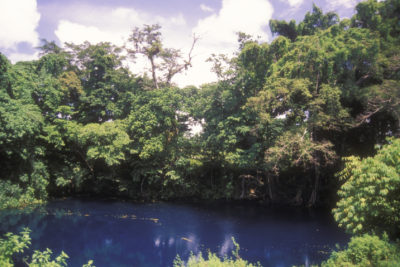 We arranged a car and drove part way around the island to a tourist spot called Blue Lagoon, which sure enough was blue. In Luganville proper we heard about the overwhelming need for the work they were doing, from an American missionary couple, and we swapped deep, enlightened thoughts with a councilman from Cairns and his wife at a kava house.
We arranged a car and drove part way around the island to a tourist spot called Blue Lagoon, which sure enough was blue. In Luganville proper we heard about the overwhelming need for the work they were doing, from an American missionary couple, and we swapped deep, enlightened thoughts with a councilman from Cairns and his wife at a kava house.
Kava derives from the same plant as betel. It delivers mild calming effects and euphoria. As a drink its effects are short lived and mild akin to kratom and, I expect, qat (I wrote about the effects of betel in a story about Papua New Guinea on 3QD here). But as first-timers, we sat into the night for drink after drink of kava, deep in conversation with the councilman and his wife, as long as the eye-rolling and tolerant proprietors would let us.
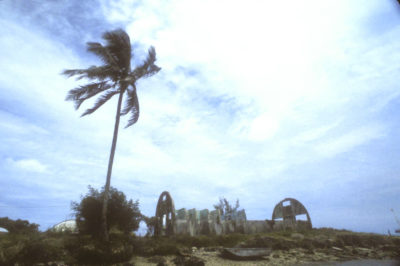 At the time Luganville, really, was just several thousand people arrayed around the ruins of several corroding quonset huts at a wide place in a track that didn’t even circumnavigate the island. Today is a different story. Today Luganville has a shiny new, controversial Chinese built port.
At the time Luganville, really, was just several thousand people arrayed around the ruins of several corroding quonset huts at a wide place in a track that didn’t even circumnavigate the island. Today is a different story. Today Luganville has a shiny new, controversial Chinese built port.
A breeze of concern swept from the Pacific outward to western capitals last spring when China and the Solomon Islands signed a security agreement. Rumors that something like this was afoot sent US Secretary of State Antony Blinken scrambling off on a slapped-together meeting in Fiji with 18 Pacific leaders, most attending online.
Feigning to be first and foremost focused on Pacific island affairs left Blinken forlorn and looking like it, standing alongside the acting Fijian Prime Minister, in Fiji, lamely promising to open a new embassy … in the Solomon Islands. Blinken wanted to be anywhere but Nadi because anywhere else would have been closer to his preoccupation that day, February 12th, less than two weeks before the Russian invasion of Ukraine.
The question of China’s Pacific expansion had festered for some time. A full four years before, the Sydney Morning Herald fretted that Chinese officials had approached Vanuatu officials about a security arrangement, and how that kind of thing could lead to a Chinese military base far too close to Australian shores.
The Luganville wharf’s stated purpose is to host cruise ships, but it’s big enough to service naval vessels too. A security analyst called the wharf “overkill” for the cruise industry on Australia’s Channel 9. It is “large enough to accommodate large Chinese naval service combatants, guided missile destroyers and cruisers.” I checked and I can only find 61 cruise ship arrivals scheduled for 2023 in all of Vanuatu.
Building a port for cruise ships could be good for China even if it really is just for cruise ships. The worry is that China could move on Vanuatu as they did at the Hambantota port in Sri Lanka, what analysts call “debt trap diplomacy.”
The port on Sri Lanka’s southern coast was built with loans from a Chinese state-owned bank and opened in 2010. But when the Sri Lankan government struggled to pay its debt, under a 2018 deal Chinese firms emerged with a 70 per cent stake and 99 year lease.
“What the Chinese tend to do is that they put heavy investment into countries that simply don’t have the means to pay back the debt,” an expert told Australia’s Channel 9. “If China can get a country so deep in debt that it can’t pay back that debt, then they will take something else in return … (like a) port.”
•••••
The first we heard of a cyclone was Monday afternoon in Vila. Next table over two bright pink corpulent fellows were saying “Bluh bluh rain bluh bla cyclone bluh Fiji.” I leaned over to inquire. “Yeah,” one said, “Its southeast of here, toward Fiji. We just had a look at it on the Internet, a big, mean thing. It’s what’s been causing all the rain.”
This was notable because we were bound for Fiji in 18 hours. In the taxi home we heard cyclone warnings in three languages on Vanuatu’s AM radio station, with a particular warning for the southeast island group centered around the cult-and-volcano island of Tanna. By now, the cyclone had a name – may I introduce you to Tropical Cyclone Jo.
We let ourselves imagine the pounding reef out at the end of Erakor Island was meaner that it ought to have been, and maybe it was. Next morning, though, the lady behind the desk was ebullient. About the cyclone, “It’s gone,” she beamed.
Really?
“Yes, I think it has gone to Fiji.”
We flew Air Vanuatu, operated by the national airline of Fiji, Air Pacific, using a leased Qantas pilot, to Fiji. In the air Captain Richardson showed us the cyclone – 200 miles south of our itsy bitsy, teeny little insignificant 737:
“You can see the associated weather systems out the right side of the aircraft.”
Twice he told us there was some “rain in the area” of Nadi airport, and when we came in to land he was proven right. Scarcely 100 feet over the ground, already on the airport grounds past the fence and over the grass to the tarmac, we were lashed by blinding rain, and Captain Richardson floored it, pulled us up and took us around. With the full power of the jets, real, last second, locomotive straining and heavy lifting pulled us back into the air, for we must have been very near stall speed. The captain eased back as soon as he could and tried a nonchalant, nothing to see here approach:
“As you could see there,” he told us, like something he was just mentioning, “It was a bit too rainy for me to put us down, so we’ll call it a missed approach and go round and I’ll try to have us on the ground in seven or eight minutes time.” And that he did, and you could see on the way how it had been raining tons and buckets over northwest Viti Levu for the past three days.
For two days bands of rain lashed our buri. Everything, every last possible thing, was wet, and had been wet, and much had begun to mildew. Nothing had the slightest intention even to begin to dry. Wind whipped coconut palms into frenzy, rain hammered our roof and frogs utterly gloried in it all.
We sat in the twilight and watched a dozen frogs in every direction at every moment, bounding, jumping, head up, head down, throat pulsing, hurrying this way or that, up the path or under the bush, and we saluted them and their day.
